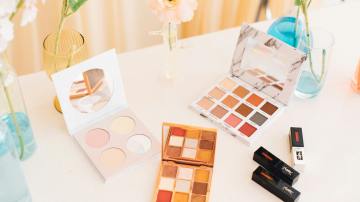Owed to her father’s background in perfumery, Amélie Huynh had a desire to develop her own fragrance brand. But rather than launch a new brand from scratch, she sought to tap into France’s perfume heritage by revitalizing an existing house. In 2015, she acquired the French brand D’Orsay, and in 2019, she reopened the house with a fresh boutique on Paris’s Left Bank and new fragrance compositions like the musky floral “J’ai l’air de ce que je suis J.R.” In 2024, Huynh brought D’Orsay to the U.S. market through retailers like Printemps New York and Stéle.
“We kept the DNA of D’Orsay, which is based on love, on a heartbeat. It was very romantic. And I thought that the story was amazing. In fact, I didn’t buy it to make it new. I wanted to make it more timeless,” said Huynh.
Revitalizing existing brands with new packaging and updated scents is far from unusual in fragrance, particularly in the post-2020 perfume boom. Phlur, founded in 2016, got a reboot in 2022, while Commodity, founded in 2013, was revived in 2021 following its 2019 bankruptcy. But unlike those brands, D’Orsay’s original audience is no longer there to be counted upon: Sources point to the brand’s founding as early as 1865, while D’Orsay’s current storefront traces its lineage to 1830, when its namesake Alfred d’Orsay created a perfume for his lover Marguerite Blessington.
Under Huynh, D’Orsay joins a roster of centuries-old perfume brands to have staged comebacks and expansions amid the post-Covid fragrance boom. April data from NielsenIQ found the U.S. fragrance market grew to $9.8 billion in 2025, showing 20.1% year-over-year growth. If done successfully, those revitalized names stand to tap into an existing brand universe and hundreds of years of history to speak to niche perfume consumers’ desire for heritage and authenticity.
Officina Profumo-Farmaceutica di Santa Maria Novella, established in 1221, was acquired by Italmobiliare in 2021 and welcomed ex-Balenciaga exec Ludivine Pont as CEO in July. Creed, the British fragrance house founded in 1760, was acquired by Kering in 2023 for $3.8 billion. LVMH snapped up Officine Universelle Buly 1803 in 2021 following its 2014 revival. Houbigant, the French house founded in 1775, opened its first freestanding store in June.
Those longstanding names stand in contrast to a stream of new perfume brands like Dedcool, Kayali and Snif, which have found success by tapping into contemporary scent profiles and formats like gourmands and body mists. But while they may not be as zeitgeisty as 21st-century made brands, an existing brand can give founders a head start in developing a compelling story.
“Sure, you can come up with something new, but that means embarking upon an entirely new [journey]. You’ve got to design the fragrance, you’ve got to design the bottle, you’ve got to come up with the marketing strategy, you’ve got to figure out the distribution strategy, etcetera, which can be hit or miss,” said Wendy Nicholson, managing director in Baird’s Global Consumer Investment Banking Group. “The idea of going back and taking some of these older fragrances and bringing them back to life, or rededicating effort to them and bringing them back to the forefront, makes a ton of sense.”
The revival of heritage fragrance houses also highlights the category’s unique appeal in beauty, where emotional resonance can trump factors like innovation or scientific advancements.
“At the end of the day, fragrance is all about a feeling and a memory,” said Nicholson. “It’s that sort of ephemeral aspect of fragrance. It’s how it makes you feel, as opposed to a clinical backing or anything like that, which is what we see drive the newer skin-care brands, for example.”
But reviving heritage houses is still a well-trodden path in the luxury sphere.
“In luxury, in particular, there’s an emphasis on longevity,” said Ariel Ohana, managing partner of investment bank Ohana & Co. “There’s a trend of reviving all brands. The first wave, even before fragrance, was in leather goods. And I think a lot of what we’re seeing in fragrance is actually inspired by what’s been done in leather goods, and some successes.”
Ohana cited Goyard as an example of such a success. In 1998, Jean-Michel Signoles acquired the French leather house and has since turned the brand from a defunct leather maker into a signature bag worn by the likes of Bella Hadid and Pharrell.
Capitalizing on 100-year-old brand equity is not a quick path, however. It took Goyard over a decade to make its monogrammed bags a fashion staple again. While Italmobiliare first invested in Santa Maria Novella in 2020 and helped it grow to an annual revenue of €22.6 million ($26 million) in 2021, it was mechanical engineer Eugenio Alphandery who originally revitalized the brand when he bought the company in 1989 for 800 million lira, equivalent to about $480,000.
“If you think that having a brand that’s a century old means you’re buying a century, in terms of marketing, you’re not,” said Ohana. “You are buying a universe. You’re buying the magic of the legacy, the history. … But it still takes time.”
While investors and conglomerates may still find such storied brands to be attractive acquisitions in a hot fragrance market, brands founded in centuries past don’t have a monopoly on heritage and authenticity. In 2024, Kering Beauté acquired a minority stake in Matiere Premiere, the niche perfume brand founded in 2019. The brand name may be new, but its perfume lineage is not — founder Aurélien Guichard is a seventh-generation perfumer from Grasse. For consumers spending hundreds of dollars on a single fragrance, that lineage may be enough to tip the scales.
“Perfume is quite expensive,” said Huynh. ”You have to be really serious about perfume. I think that heritage brings trust.”




